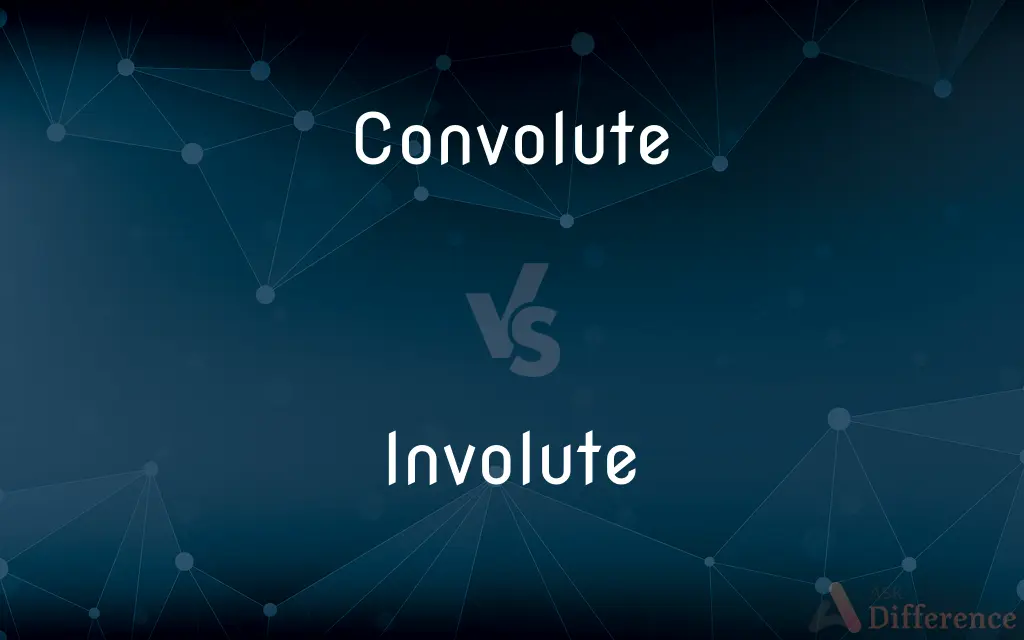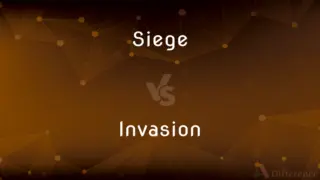Convolute vs. Involute — What's the Difference?
By Urooj Arif & Fiza Rafique — Updated on April 16, 2024
Convolute involves complex and intricate arrangements or processes, while involute pertains to something intricate or complex in a rolled or curled form, often used in technical contexts.

Difference Between Convolute and Involute
Table of Contents
ADVERTISEMENT
Key Differences
Convolute typically describes something that is highly complex, twisted, or intricately folded. On the other hand, involute specifically refers to a geometric or physical form that is rolled inward or spiraled.
In literature or conversation, when something is described as convolute, it suggests complications or confusion in understanding, process, or structure. Conversely, involute, often used in engineering or mathematics, describes precise curves or mechanisms such as gears with teeth that are characterized by rolling or enveloping movements.
Convolute can also imply a method or explanation that is unnecessarily complex and difficult to follow. Whereas involute describes a form or shape that is not necessarily complicated in function but is detailed in its design and execution.
In botanical terms, convolute refers to a specific type of leaf arrangement where leaves are rolled longitudinally toward the upper side. In mechanical engineering, an involute gear is one where the teeth are constructed from involute curves, improving performance and longevity.
While convolute can be used to describe both physical and abstract complexities, involute is more commonly applied in a technical context where precision and specific geometric properties are crucial, such as in the design of mechanical systems.
ADVERTISEMENT
Comparison Chart
Definition
Twisted or complexly folded
Rolled or spiraled, often geometrically
Usage Context
General complexity, often abstract
Technical, precise physical forms
Typical Applications
Literature, general discussion
Engineering, botany
Implication
Complexity, confusion
Detailed, precise design
Example in Nature
Leaf arrangement in botany
Spiral shells in nature
Compare with Definitions
Convolute
Twisted or coiled together; complex.
The plot of the novel was convoluted.
Involute
Rolled inward or curled.
The involute design of the shell fascinated the collectors.
Convolute
Intricately folded or wound.
The artist's use of convolute lines creates a sense of depth.
Involute
Used to describe certain types of gear teeth.
Involute gear teeth are designed for minimal wear and tear.
Convolute
Characterized by being overly complex.
The legal language in the document was unnecessarily convolute.
Involute
Having edges or parts that are wound about each other.
The involute gears are crucial for the machine's smooth operation.
Convolute
Complicated and difficult to follow.
His explanation was so convoluted that few could understand.
Involute
A curve traced by a point on a string as it unwinds from another curve.
The mathematician explained the properties of an involute curve.
Convolute
In botany, a term describing leaf arrangements.
The convolute petals of the flower added to its beauty.
Involute
Complex but precise.
The clock featured an involute mechanism that was both intricate and elegant.
Convolute
Rolled or coiled together in overlapping whorls, as certain leaves, petals, or shells.
Involute
In mathematics, an involute (also known as an evolvent) is a particular type of curve that is dependent on another shape or curve. An involute of a curve is the locus of a point on a piece of taut string as the string is either unwrapped from or wrapped around the curve.It is a class of curves coming under the roulette family of curves.
Convolute
To coil or fold or cause to coil or fold in overlapping whorls.
Involute
Intricate; complex.
Convolute
(transitive) To make unnecessarily complex.
Involute
(Botany)Having the margins rolled inward.
Convolute
(transitive) To fold or coil into numerous overlapping layers.
Involute
(Zoology)Having whorls that enclose and obscure earlier whorls. Used of a gastropod shell.
Convolute
(transitive) To confuse, mix up (something) with something else.
Involute
To curl inward.
Convolute
Convoluted.
Involute
The curve traced by a point as if it were on a taut string being unwound from another curve.
Convolute
Coiled such that one edge is inside, and one outside the coil, giving a spiral effect in cross section.
Involute
(formal) Difficult to understand; complicated.
Convolute
Rolled or wound together, one part upon another; - said of the leaves of plants in æstivation.
Involute
(botany) Having the edges rolled with the adaxial side outward.
Convolute
Curl, wind, or twist together
Involute
Having a complex pattern of coils in which younger whorls only partly surround older ones.
Convolute
Practice sophistry; change the meaning of or be vague about in order to mislead or deceive
Involute
(biology) Turned inward at the margin, like the exterior lip of the shells of species in genus Cypraea.
Convolute
Rolled longitudinally upon itself;
A convolute petal
Involute
(biology) Rolled inward spirally.
Involute
To roll or curl inwards.
Involute
(geometry) A curve that cuts all tangents of another curve at right angles; traced by a point on a string that unwinds from a curved object. Category:en:Curves
Involute
Rolled inward from the edges; - said of leaves in vernation, or of the petals of flowers in æstivation.
Involute
Turned inward at the margin, as the exterior lip of the Cyprea.
Involute
A curve traced by the end of a string wound upon another curve, or unwound from it; - called also evolvent. See Evolute.
Involute
Especially of petals or leaves in bud; having margins rolled inward
Involute
(of some shells) closely coiled so that the axis is obscured
Common Curiosities
Can convolute be used to describe physical objects?
Yes, particularly when these objects are twisted or intricately folded.
What distinguishes an involute gear?
Its teeth are shaped from involute curves, which ensure smooth operation and less wear.
What does convolute mean in general usage?
It refers to something extremely complex or intricate.
Is convolute always negative?
Not necessarily, though it often implies excessive complexity that can be perceived as a negative trait.
Does involute have applications beyond engineering?
Yes, it is also used in describing natural forms and mathematical concepts.
How is involute used in engineering?
Involute describes a type of curve used in the design of gear teeth for optimal function.
What industries use involute designs?
Industries like mechanical engineering and watchmaking, where precision is crucial.
Are convolute and involute interchangeable?
No, as convolute generally implies complexity in a broader sense, while involute refers to specific geometric forms or mechanisms.
What is an example of a convolute structure in nature?
Some plants have leaves that are convolutely arranged around the stem.
How are involute concepts taught in mathematics?
They are often taught through geometry, focusing on curves and their properties.
Share Your Discovery

Previous Comparison
Siege vs. Invasion
Next Comparison
Sforzando vs. RinforzandoAuthor Spotlight
Written by
Urooj ArifUrooj is a skilled content writer at Ask Difference, known for her exceptional ability to simplify complex topics into engaging and informative content. With a passion for research and a flair for clear, concise writing, she consistently delivers articles that resonate with our diverse audience.
Co-written by
Fiza RafiqueFiza Rafique is a skilled content writer at AskDifference.com, where she meticulously refines and enhances written pieces. Drawing from her vast editorial expertise, Fiza ensures clarity, accuracy, and precision in every article. Passionate about language, she continually seeks to elevate the quality of content for readers worldwide.















































